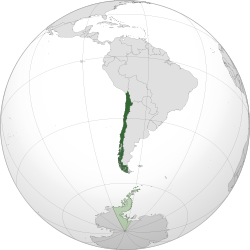
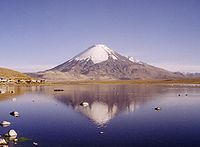
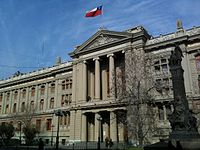
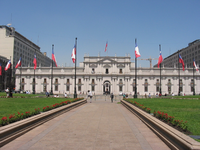
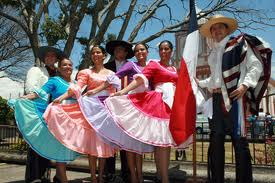
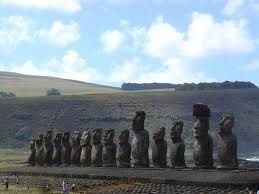
| Fundation
In 1520, while attempting to circumnavigate the earth, Ferdinand Magellan discovered the southern passage now named after him, the Strait of Magellan.
President
Sebastián Piñera Echenique Economy
The Chilean economy is highlighted among the most stable and booming economies in the world. The market stimulates free trade and open competition, at the same time that the authorities foster and protect fiscal discipline. The growth of the last decade has reached close to 5% annually.
The sustained growth confirms that the economy in Chile is one of the most open and dynamic, a situation that has allowed them to sign free trade agreements with markets that represent almost two thirds of the world’s population.
The most significant contributors to the growth of the recent decade are fiscal responsibility and the social programs that have significantly reduced poverty, increasing the amount of young adults who enter college by four.
The productive agricultural activity has grown in such a way that all the programs aim to turn Chile into an agricultural power. A notable example is the farming of salmon and trout, making the country the second largest exporter in the world, second only to Norway. Climate
The climate of Chile comprises a wide range of weather conditions across a large geographic scale, extending across 38 degrees in latitude, making generalisations difficult.
According to the Köppen system, Chile within its borders hosts at least seven major climatic subtypes, ranging from desert in the north, to alpine tundra and glaciers in the east and south east, humid subtropical in Easter Island, Oceanic in the south and Mediterranean climate in central Chile. There are four seasons in most of the country: summer (December to February), autumn (March to May), winter (June to August), and spring (September to November). |
Culture
During the period between early agricultural settlements and to the late pre-Hispanic period, northern Chile was a region of Andean culture that was influenced by altiplano traditions spreading to the coastal valleys of the north. While southern regions were areas of Mapuche cultural activities. Through the colonial period following the conquest, and during the early Republican period, the country's culture was dominated by the Spanish. Other European influences, primarily English, French, and German began in the 19th century and have continued to this day. German migrants influenced the Bavarian style rural architecture and cuisine in the south of Chile in cities such as Valdivia, Frutillar, Puerto Varas, Osorno, Temuco, Puerto Octay, Llanquihue, Faja Maisan, Pitrufquén, Victoria, Pucón and Puerto Montt.
Attractions for tourist
The main attractions for tourists are places of natural beauty situated in the extreme zones of the country: San Pedro de Atacama, in the north, is very popular with foreign tourists who arrive to admire the Incaic architecture, the altiplano lakes, and the Valley of the Moon. In Putre, also in the North, there is the Chungará Lake, as well as the Parinacota and the Pomerape volcanoes, with altitudes of 6,348 m and 6,282 m, respectively. Throughout the central Andes there are many ski resorts of international repute, including Portillo, Valle Nevado and Termas de Chillán. The main tourist sites in the south are the coastal area around Tirúa and Cañete with the Isla Mocha and the Nahuelbuta National Park, Chiloé Archipelago and Patagonia, which includes Laguna San Rafael National Park, with its many glaciers, and the Torres del Paine National Park. The central port city of Valparaíso, which is World Heritage with its unique architecture, is also popular. Finally, Easter Island in the Pacific Ocean is one of the main Chilean tourist destinations.
For locals, tourism is concentrated mostly in the summer (December to March), and mainly in the coastal beach towns. Arica, Iquique, Antofagasta, La Serena and Coquimbo are the main summer centres in the north, and Pucón on the shores of Lake Villarrica is the main centre in the south. Because of its proximity to Santiago, the coast of the Valparaíso Region, with its many beach resorts, receives the largest number of tourists. Viña del Mar, Valparaíso's northern affluent neighbor, is popular because of its beaches, casino, and its annual song festival, the most important musical event in Latin America. Pichilemu in the O'Higgins Region is widely known as South America's "best surfing spot," according to Fodor's.
In November 2005, the government launched a campaign under the brand "Chile: All Ways Surprising," intended to promote the country internationally for both business and tourism
Cousine
Chilean cuisine is a reflection of the country's topographical variety, featuring an assortment of seafood, beef, fruits, and vegetables. Traditional recipes include asado, cazuela, empanadas, humitas, pastel de choclo, pastel de papas, curanto and sopaipillas.[164] Crudos is an example of the mixture of culinary contributions from the various ethnic influences in Chile. The raw minced llama, heavy use of shellfish and rice bread were taken from native Quechua Andean cuisine, (although now beef brought to Chile by Europeans is also used in place of the llama meat), lemon and onions were brought by the Spanish colonists, and the use of mayonnaise and yogurt was introduced by German immigrants, as was beer. Source: www.wikipedia.org |